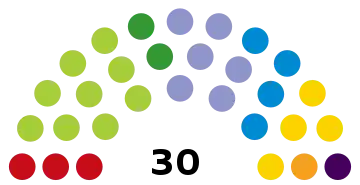Parliament of Åland
The Lagting, or Lagtinget, is the parliament of Åland, an autonomous, demilitarised and unilingually Swedish-speaking territory of Finland. The Lagting has 30 seats, which makes for approximately one seat per 700 voters in 2022.[1]

A parliament chamber
Parliament of Åland Ålands lagting | |
|---|---|
 | |
| Type | |
| Type | |
| Leadership | |
| Structure | |
| Seats | 30 |
 | |
Political groups | Government (19)
Opposition (11)
|
| Elections | |
Last election | 20 October 2019 |
Next election | 15 October 2023 |
| Meeting place | |
 | |
| Mariehamn | |
| Website | |
| www.lagtinget.ax | |
Legislative work is carried out in three standing committees:[2]
- Committee on Legal Affairs and Culture
- Committee on Economic and Monetary Affairs
- Committee on Social Affairs and the Local Environment
Electoral system
The 30 members of the Parliament of Åland are elected every four years by proportional representation, with seats allocated using the d'Hondt method.[3][4] The age limit for voting rights is 18 years, in addition to which Åland's right to vote in the home region is a prerequisite for the stand for election.[5]
Latest election
 | |||||
|---|---|---|---|---|---|
| Party | Votes | % | Seats | +/– | |
| Åland Centre | 3,970 | 27.84 | 9 | +2 | |
| Liberals for Åland | 2,803 | 19.66 | 6 | –1 | |
| Moderate Coalition for Åland | 1,967 | 13.80 | 4 | –1 | |
| Non-aligned Coalition | 1,935 | 13.57 | 4 | +1 | |
| Åland Social Democrats | 1,312 | 9.20 | 3 | –2 | |
| Sustainable Initiative | 1,187 | 8.33 | 2 | +2 | |
| Future of Åland | 666 | 4.67 | 1 | –1 | |
| Ålandic Democracy | 418 | 2.93 | 1 | 0 | |
| Total | 14,258 | 100.00 | 30 | 0 | |
| Valid votes | 14,258 | 97.69 | |||
| Invalid/blank votes | 337 | 2.31 | |||
| Total votes | 14,595 | 100.00 | |||
| Registered voters/turnout | 20,946 | 69.68 | |||
| Source: ASUB | |||||
Election table (1979-2019)
 |
|---|
| Election | Seats | ||||||||||
| ÅC | LÅ | ÅS | FS | ObS | G | Åfg | ÅF | MS | ÅD | Hi | |
| 1979 | 14 | 9 | 3 | 4 | |||||||
| 1983 | 11 | 9 | 5 | 5 | |||||||
| 1987 | 9 | 8 | 4 | 5 | 2 | 2 | |||||
| 1991 | 10 | 7 | 4 | 6 | 3 | ||||||
| 1995 | 9 | 8 | 4 | 6 | 3 | ||||||
| 1999 | 9 | 9 | 3 | 4 | 4 | 1 | |||||
| 2003 | 7 | 7 | 6 | 4 | 3 | 1 | 2 | ||||
| 2007 | 8 | 10 | 3 | 3 | 4 | 2 | |||||
| 2011 | 7 | 6 | 6 | 4 | 4 | 3 | |||||
| 2015 | 7 | 7 | 5 | 3 | 2 | 5 | 1 | ||||
| 2019 | 9 | 6 | 3 | 4 | 1 | 4 | 1 | 2 | |||
| Source: Ålands statistik- och utredningsbyrå | |||||||||||
See also
References
- Arter, David (2022). "Personal representation or party representation? Elections in the autonomous Åland Islands". Regional & Federal Studies. 32 (4): 511–524. doi:10.1080/13597566.2022.2047940. ISSN 1359-7566. S2CID 248113785.
- "Utskott och organ". Ålands lagting (in Swedish). October 14, 2015. Retrieved September 14, 2021.
- E-voting in a Small Scale –the Case of Åland
- "Ahvenanmaan vaaleissa valta vaihtui: Keskusta voitti, sosiaalidemokraatit hävisivät". YLE (in Finnish). 21 October 2019. Retrieved September 14, 2021.
- "Vem får rösta?". Val.ax (in Swedish). 2019. Retrieved September 14, 2021.
This article is issued from Wikipedia. The text is licensed under Creative Commons - Attribution - Sharealike. Additional terms may apply for the media files.